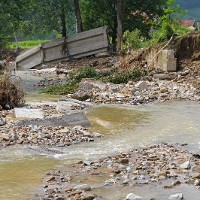Financial preparation for natural disasters
More than 9,000 people lost their lives in the 1985 Mexico City earthquake, with the direct economic cost estimated at about US$8 billion (2010). Mexico lies in an active seismic region and in the path of tropical storms; its population and economy are highly exposed to natural hazards. The 1985 earthquake prompted substantial efforts in Mexico to identify, reduce, and finance disaster risk before the event, and led the country to work with IIASA and partners to examine different options for risk management. Partly informed by IIASA analysis, in 2006 Mexico became the first country to transfer public sector natural catastrophe risk by transferring it to the international reinsurance and capital markets. The Mexico model set a global precedent for similar public risk management strategies, and other disasterexposed countries and regions have followed suit, such as Caribbean countries where IIASA has been active.
The IIASA CATSIM model
CATSIM was designed by IIASA scientists for experts and non-experts to explore resilience
and different strategies to manage risks with a focus towards risk financing strategies. It does
not point out “optimal” strategies, but yields insights into the pros and cons of different
policy options. For the Mexican government, the interactive model provided a clear picture of
the different risks posed by earthquakes to public inances and helped identify those that could be cost-effectively transferred to the international inance markets. As carried out for Mexico and the Caribbean, IIASA provides hands-on training in CATSIM for governments.
Impacts
- CATSIM has been used for a number of World Bank projects and their World Development Report to estimate disaster risk in more than 80 countries. It informed an initiative by the Inter-American Development Bank to establish the Regional Insurance Facility for Central America, which helps small countries to pool risks and access outside capital to hedge its risk.
- CATSIM analysis informed the design of the Caribbean Catastrophe Insurance Facility (CCRIF) in 2007, the first multicountry risk pool and premier regional disaster risk management pool, which has been supported by the World Bank and key donors such as the UK Department for International Development. A CATSIM workshop with Caribbean countries was held in Barbados in 2007 during the run-up to the formation of the CCRIF. The workshop, gathering senior policymakers and disaster risk practitioners, helped to understand the risks imposed by disasters and identify cost-efficient and acceptable strategies for managing these risks.
- IIASA also contributed to the bi-annual Global Assessment Reports of the UN Office of Disaster Risk Reduction. The 2015 report and process supporting it served as important input to the 3rd UN World Conference on Disaster Risk Reduction in Sendai in Mach 2015, where IIASA co-lead two sessions.
- During 2011–2012 IIASA used CATSIM to support a major study by the government disaster agency (BNGRC) of Madagascar on “Mainstreaming Disaster Risk Management and Climate Change in Economic Development.” Madagascar, which suffers an average of two tropical cyclones every three years, sought IIASA assistance in the wake of cyclone Gafilo which killed 363 people and caused damages of 5% of GDP. The BNGRC plans to adopt risk management and technology approaches to help reduce disaster impacts.
- CATSIM analysis is informing deliberations on a rationale for the before UN Framework Convention on Climate Change Loss and Damage Mechanism including the costs of supporting vulnerable countries’ risk reduction and risk financing activities by setting up a global fund that absorbs different levels of risks.

Financial Preparation for Natural Disasters (PDF)


